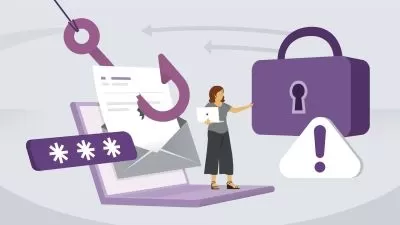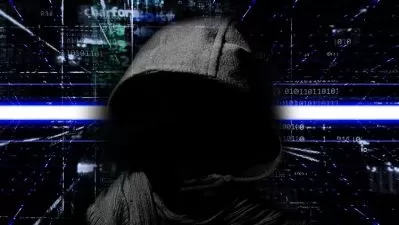Master Advanced Cyber Security: Tools, Techniques, Forensics
Peter Alkema
17:49:54
Description
Unlock expert skills in cyber security with hands-on training in advanced tools, network analysis, and email forensics
What You'll Learn?
- Implement and Configure Advanced Security Tools: Gain hands-on experience in installing and configuring advanced security tools such as Kali Linux, Wireshark
- Conduct Comprehensive Security Assessments: Learn to perform thorough security assessments using tools like Nmap and Nikto to identify vulnerabilities
- Perform Email Forensics and Network Analysis: Understand the principles of email forensics, including analyzing email headers, validating email servers
- Enhance System Security through Best Practices: Develop skills in applying best security practices, configuring firewalls, managing secure passwords with tools
Who is this for?
What You Need to Know?
More details
DescriptionImagine being the hero who prevents a major cyber attack, saving your company from potential disaster. You’re in the server room, alarms blaring, and you deftly navigate through sophisticated security tools, pinpointing and neutralizing the threat in real-time. This could be you.
Welcome to “Master Advanced Cyber Security: Tools, Techniques, and Forensics.†This course is designed to transform you from a cyber security enthusiast into a skilled professional capable of defending any network from the most advanced threats.
Become the Defender
In this comprehensive course, you’ll step into the role of a cyber security expert, mastering the essential tools and techniques needed to safeguard critical systems. From installing and configuring industry-standard software like Kali Linux, Wireshark, and Splunk to conducting detailed security assessments with Nmap and Nikto, you’ll gain hands-on experience that is crucial for real-world application.
Uncover Hidden Threats
You’ll delve deep into the world of email forensics, learning how to analyze email headers, validate servers, and uncover hidden threats. With our detailed modules, you’ll become proficient in using advanced tools to perform deep packet inspections and secure communications.
Practical Skills for Real Success
This course is not just about learning tools; it’s about applying them. You’ll engage in practical exercises that simulate real cyber security challenges, enhancing your ability to respond swiftly and effectively. By the end of this course, you’ll be equipped with the skills to conduct comprehensive security assessments, implement best practices, and maintain compliance with crucial security standards like PCI DSS.
Who this course is for:
- Aspiring Cyber Security Professionals: Individuals looking to enter the field of cyber security and develop advanced skills in network and system security.
- IT Professionals: System administrators, network engineers, and IT support personnel seeking to enhance their security expertise and protect their organizational infrastructure
- Security Enthusiasts: Hobbyists and tech enthusiasts with a passion for cyber security who wish to deepen their knowledge and practical skills
- Students and Academics: Learners in academic programs related to computer science or information technology who want to complement their theoretical knowledge with practical, hands-on experience
Imagine being the hero who prevents a major cyber attack, saving your company from potential disaster. You’re in the server room, alarms blaring, and you deftly navigate through sophisticated security tools, pinpointing and neutralizing the threat in real-time. This could be you.
Welcome to “Master Advanced Cyber Security: Tools, Techniques, and Forensics.†This course is designed to transform you from a cyber security enthusiast into a skilled professional capable of defending any network from the most advanced threats.
Become the Defender
In this comprehensive course, you’ll step into the role of a cyber security expert, mastering the essential tools and techniques needed to safeguard critical systems. From installing and configuring industry-standard software like Kali Linux, Wireshark, and Splunk to conducting detailed security assessments with Nmap and Nikto, you’ll gain hands-on experience that is crucial for real-world application.
Uncover Hidden Threats
You’ll delve deep into the world of email forensics, learning how to analyze email headers, validate servers, and uncover hidden threats. With our detailed modules, you’ll become proficient in using advanced tools to perform deep packet inspections and secure communications.
Practical Skills for Real Success
This course is not just about learning tools; it’s about applying them. You’ll engage in practical exercises that simulate real cyber security challenges, enhancing your ability to respond swiftly and effectively. By the end of this course, you’ll be equipped with the skills to conduct comprehensive security assessments, implement best practices, and maintain compliance with crucial security standards like PCI DSS.
Who this course is for:
- Aspiring Cyber Security Professionals: Individuals looking to enter the field of cyber security and develop advanced skills in network and system security.
- IT Professionals: System administrators, network engineers, and IT support personnel seeking to enhance their security expertise and protect their organizational infrastructure
- Security Enthusiasts: Hobbyists and tech enthusiasts with a passion for cyber security who wish to deepen their knowledge and practical skills
- Students and Academics: Learners in academic programs related to computer science or information technology who want to complement their theoretical knowledge with practical, hands-on experience
User Reviews
Rating
Peter Alkema
Instructor's Courses
Udemy
View courses Udemy- language english
- Training sessions 166
- duration 17:49:54
- Release Date 2024/11/17











